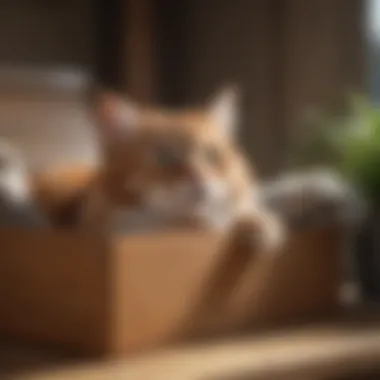Understanding Feline Fascination: Why Cats Love Boxes


Intro
The relationship between cats and boxes is a curious phenomenon that many pet owners observe. As the owner of a domestic cat, one might notice how these seemingly mundane objects captivate their feline companions. Understanding the reasons behind this preference involves looking into various aspects of feline behavior, instincts, and even evolutionary history. As the article unfolds, readers will gain insights into why these creatures are drawn to an enclosure as simple as a cardboard box.
Fascinating Facts About the Animal
Cats exhibit unique characteristics that set them apart from other pets. Their acute senses, particularly their hearing and sight, allow them to navigate environments effectively. Unlike humans, cats have a broader spectrum of vision that enables them to detect movements in low light.
Unique Characteristics
- Whisker Sensitivity: Cats have sensitive whiskers that aid in spatial awareness. This sensitivity may explain their tendency to seek out tight spaces, where they can feel secure.
- Flexible Bodies: With flexible spinal columns, cats can fit into smaller spaces than many animals. This trait allows them to explore various environments, including boxes.
Extraordinary Abilities
Felines have remarkable abilities that contribute to their fascination with boxes. Here are some examples:
- Hunting Skills: Their predatory instincts lead them to seek out hiding spots. Boxes can serve as excellent locations for stalking imaginary prey.
- Self-Comforting: Cats often knead or lie down in boxes. This behavior may provide comfort, mimicking the enclosed space they would seek in the wild.
Behavior and Habitat
Understanding the behavior and habitat of cats offers insights into their preference for boxes. Their instinctual need for safety and view of their surroundings drives many of their actions.
Natural Habitats
In the wild, cats are solitary hunters. They prefer territories where they can find cover while stalking prey. Since boxes provide similar safety, it can be inferred that they hold a form of psychological comfort for our domestic companions.
Social Structures
Unlike dogs, cats exhibit a more independent social structure. Their interactions often revolve around personal space. Boxes satisfy this need by offering a barrier from potential disturbances, enabling predators to secure their space.
Recent Scientific Discoveries
Scientific studies have begun to reveal more about why cats have a seemingly irrational attraction to boxes. Understanding these findings can add depth to the common experiences of cat ownership.
Latest Research Findings
Recent work has shown that cats exhibit decreased stress levels when given access to boxes. Research indicates that providing cats with hiding spaces reduces anxiety in environments like shelters. This outcome highlights the psychological importance of boxes as safety zones.
Breakthroughs in Animal Biology
Studies in animal biology continue to shed light on feline behavior. New findings suggest that the craving for enclosed spaces is linked to ancestral survival strategies, where hiding was essential for avoiding predators. Such insights redefine the context of a cat’s behavior in domestic settings.
Cultural Significance
Cats have held various roles in human culture throughout history. Their attributes and behaviors are often captured in folklore, art, and literature.
Animals in Folklore
Cats in many cultures symbolize mystery and independence. They have featured prominently in Egyptian mythology, where they were revered as embodiments of grace and protection.
Influence on Art and Literature
In literature and art, cats are depicted as central figures. Writers and artists have captured their enigmatic nature, often exploring themes of curiosity and autonomy. Their love for boxes inspires narratives that highlight their complex character.
Understanding why cats love boxes stretches beyond mere observation. It involves digging deep into their behavioral science and contextualizing it with respect to their evolutionary past.
By exploring these factors, readers can appreciate the layers of behavior that contribute to a cat's love of boxes. As we continue this exploration, further sections will delve deeper into the specific influence of environmental factors, shedding light on the intricacies of feline behavior.
Preface to Feline Behavior


Understanding the basics of feline behavior is crucial to unraveling the enigma of why cats are drawn to boxes. At its core, feline behavior pertains to how cats interact with their environment, other animals, and humans. This behavior not only influences their preferences, but also shapes their well-being. By grasping these nuances, cat owners can create enriched environments that cater to their pets' natural inclinations.
Defining Cat Behavior
Cat behavior involves a complex interplay of instinct, learned habits, and environmental influences. Unlike dogs, cats exhibit more solitary traits, which can make interpreting their actions more challenging. Key behaviors include hunting, playing, grooming, and territoriality. Observing these actions helps in understanding their needs and preferences. For instance, when a cat prefers a box over more elaborate toys, it reflects a deeper evolutionary instinct related to safety and comfort.
Additionally, behaviors like kneading, purring, or even hiding signify various emotional states. Understanding these signals can lead to better communication between cats and their human companions.
The Importance of Understanding Preferences
Recognizing feline preferences, particularly regarding spaces like boxes, is essential for several reasons:
- Enhancing Well-Being: Providing cats with their preferred environments fosters a sense of safety and reduces stress.
- Improving Interaction: Knowing what your cat likes leads to better play and bonding experiences.
- Identifying Health Issues: Changes in behaviors or preferences may signal health concerns that require attention.
"Cats may find comfort and security in confined spaces, which is crucial for their mental health."
By integrating an understanding of these preferences, owners can adapt their spaces effectively. Importantly, fostering an environment that respects a cat's natural tendencies directly contributes to a happier, healthier pet.
Anatomy of a Box
The anatomy of a box holds significant importance when examining why cats are so fascinated by them. Understanding the specific elements that constitute a box can offer insights into feline behavior. Each aspect of a box — its shape, size, and material — influences how cats perceive their surroundings and respond to them. The benefits of boxes extend beyond mere toys; they serve as a vital refuge for many cats, meeting their instinctual and psychological needs.
Shape and Size: Why It Matters
The shape and size of a box are crucial in determining how appealing it is to a cat. Boxes often have a defined structure that creates a safe environment. A box with low sides allows easy entry and exit, which can give a sense of control to your feline. Contrastingly, taller boxes can offer vantage points, providing an area for observation.
Cats tend to prefer snug spaces, aligning with their instinct to seek shelter. A box that is too large can feel overwhelming, while one that is adequately sized becomes a cozy den. The ideal measurements allow the cat to feel secure while also being able to stretch out when desired.
Key Factors in Shape and Size:
- Entry Point: Should not be obstructive.
- Dimensions: Must balance snugness and stretch space.
- Height Options: Promotes climbing, if appropriate.
Material Considerations
The materials used in a box also play a significant role in its appeal. Cats have a natural affinity for certain textures and substances. For instance, cardboard is a popular choice because it provides a sensation that many cats enjoy scratching and nibbling. This helps engage their predatory instincts and provides an outlet for normal behaviors.
Durable materials like plastic or wood can also have value, but they do not often elicit the same response as cardboard. Additionally, some cats are attracted to boxes that contain familiar scents from their environment, thereby increasing their sense of comfort.
When selecting boxes for your cat, consider materials that can withstand wear and tear while also catering to their tactile preferences.
Factors in Material Choice:
- Durability: Should withstand scratching.
- Texture: Should be appealing to felines.
- Scent Retention: Familiar scents can enhance comfort.
The exploration of anatomy, shape, size, and material contributes to comprehending how boxes meet the unique needs of cats. By aligning these factors with feline instinct and comfort, we can create spaces that cater to their behaviors and preferences.
Instinctual Behavior in Cats
Understanding instinctual behavior in cats is critical for comprehending why they gravitate towards boxes. This section dives into two fundamental aspects: their predatory instincts and the desire for safe spaces. The interplay of these elements shapes how cats interact with their environment and informs their attachment to boxes.
Predatory Instincts
Cats are natural hunters. Their predatory instincts drive much of their behavior. When a cat encounters a box, it views it through the lens of its ingrained hunting tactics. The box can represent both a place to ambush prey and a position from which to observe surroundings with stealth. This behavior is rooted in their evolutionary past, where hiding and pouncing were vital for survival.
Important Aspects of Predatory Behavior
- Ambush Tactics: Boxes provide a sense of concealment, allowing cats to stalk and pounce on imaginary prey, replicating hunting experiences.
- Curiosity and Exploration: The box serves as an object of intrigue, prompting exploration, which stimulates mental development.
- Security in Ambush: A confined space offers safety while they assess potential threats or target their 'prey'.
In this context, boxes are not just playthings; they are tools that feed into a cat’s natural instincts, enhancing their cognitive engagement with their environment.


Safe Spaces: An Evolutionary Perspective
The concept of safe spaces is deeply rooted in cat behavior. Historically, feline ancestors needed secure environments to protect themselves from predators and to raise their young. The box serves as a modern manifestation of this need for shelter and security.
Key Elements of Safe Spaces
- Protection from Threats: A box gives a cat a retreat from perceived dangers, creating a haven where they feel secure.
- Stress Reduction: Enclosed spaces can help mitigate environmental stressors, providing cats a sanctuary to relax and recharge.
- Nurturing Instincts: For mother cats, boxes are ideal for giving birth and caring for kittens, making these structures an integral part of maternal behavior.
Creating an environment that considers these instinctual needs leads to a happier and healthier cat. It is essential for cat owners to understand how instinctual behaviors intersect with their domestic environments, as this knowledge fosters better care and enhances the lives of feline companions.
Understanding these instinctual behaviors equips owners with the tools to enrich their cats’ lives, catering to their natural tendencies and ensuring a harmonious household.
Psychological Factors
Understanding psychological factors is vital for comprehending why cats exhibit such a strong attraction to boxes. The behavior of cats often relates closely to their emotional state and mental well-being. Recognizing these elements can help owners create a more conducive environment that aligns with their pets' psychological needs.
Stress Relief and Comfort Zones
Cats are known for being sensitive creatures, often affected by their surroundings. Boxes provide an immediate sense of security. The enclosed nature of a box mimics a den-like environment. This sense of confinement can help reduce stress levels.
Here are some important points regarding stress relief:
- Safety: Boxes allow cats to retreat from potential threats. This is particularly important in multi-pet households.
- Anxiety Management: A box serves as a personal space where cats can nap or observe their environment. This independent space can lower anxiety levels.
- Environmental Control: Boxes can act as a buffer. They help reduce overstimulation from noise or visual stimuli in a busy household.
Creating comfort zones is not just a luxury for cats; it is essential for their emotional health. Owners should consider providing various box options to promote a sense of well-being.
Territorial Behavior and Boxes
Territorial instincts play a significant role in various feline behaviors. Cats are naturally territorial animals, and boxes serve to enhance this aspect of their personality. Both instinct and learned behaviors shape how cats perceive their surroundings.
When cats explore boxes, they assess them as potential territories. Here are significant insights on this behavior:
- Claiming Space: A box is an easy way for a cat to claim space within the home. They may rub against it or sit inside to establish ownership.
- Monitoring: Boxes offer a vantage point, allowing cats to observe their environment while still feeling hidden. This allows them to keep watch over their claimed territory.
- Competition: In homes with multiple cats, boxes can hold immense importance as they can become points of competition. Each cat may need its own box to avoid conflict.
Environmental Considerations
Understanding how the environment influences feline behavior is crucial for grasping why cats are drawn to boxes. The surroundings in which a cat resides can significantly affect its choices and preferences. Environmental considerations encompass various factors that shape a cat's lifestyle, including spatial arrangement, comfort levels, and safety perceptions.
The Role of Environment on Cat Behavior
Felines are sensitive animals. Their behavior often reflects the space they inhabit. Various elements of the environment can either encourage or deter cats from engaging in specific activities, such as playing or hiding in boxes. For example, if a home has cluttered spaces, cats might feel anxious and less likely to explore.
In a well-organized and enriched environment, a cat may find boxes more enticing. Boxes create positions of advantage, allowing cats to observe while remaining hidden from potential threats. This behavior aligns with their instinctual need for safety. Always providing multiple pathways for escape can also enhance a cat's sense of security.
Often, owners can improve their cat's engagement and comfort by rearranging furniture or adding more boxes in suitable locations. It is smart to keep in mind the height and placement of these boxes, as cats often prefer elevated or secluded spots.
Impact of Domestic Spaces on Feline Preferences
The design and structure of domestic spaces affect feline preferences significantly. Open floor plans may seem spacious but can leave cats feeling exposed and vulnerable. Contrastingly, homes with nooks, crannies, and various levels provide better concealment options. More places to hide lead to increased comfort for many cats.
Boxes can serve as multifunctional elements in such environments:
- Hiding Spaces: Cats can retreat and regroup.
- Play Spaces: Boxes can become engaging play areas.
- Stress Relief: A simple box can serve as a refuge, reducing stress in a busy household.
Moreover, the types of materials present in these spaces can contribute to their size and texture preferences. Cardboard boxes, for instance, offer warmth and insulation while being lightweight and easy to manipulate. Cats have shown a strong affinity for specific types of boxes, depending on how they align with their environmental needs.
In summary, understanding the environmental context and how it shapes feline behavior is imperative for creating a cat-friendly home. Each detail, from spatial design to material choices, informs how a cat interacts with its surroundings and finds the comfort it seeks in boxes.
Research and Observations


Understanding the topic of research and observations is crucial in analyzing why cats are drawn to boxes. Research illuminates the underlying aspects of feline behavior, combining both scientific study and anecdotal experiences to create a fuller picture. It encapsulates studies that explore various phenomena linked to cat behavior towards boxes, shedding light on their instincts and preferences.
Research in this field not only enhances our understanding of individual cat behavior but also informs us about collective tendencies observed across different breeds and environments. Observational studies complement research, providing real-world insights into how cats interact with boxes. This balance between empirical data and observation results in a comprehensive understanding of this fascinating behavior.
Studies on Feline Box Behavior
Various studies have explored the relationship between cats and boxes. Most notably, a pivotal study published by the Journal of Feline Medicine and Surgery highlights the instinctual draw of boxes as safe havens. The study observed that cats exposed to boxes displayed reduced stress levels in contrast to those without access to such environments. In this research, stress indicators such as vocalizations and physical agitation were significantly lower for cats with box access.
Furthermore, a considerable research initiative on feline behavior reveals that boxes serve as crucial stimuli for enrichment and play. The research documented behaviors such as entering, exploring, and even resting in boxes. This behavior supports the notion of boxes offering both physical and psychological safety. The presence of boxes provides a private space, where cats can retreat and feel secure.
Case Studies of Box Affection
Individual case studies further validate the collective research findings regarding box affection. In one case, a family documented their cat, Whiskers, and his interactions with different types of boxes over a six-month period. They observed that Whiskers favored smaller, enclosed boxes as they provided a level of safety and comfort. The family noted that Whiskers exhibited decreased anxiety and was more playful when he had a box to interact with.
Another striking case involved a shelter where rescued cats showed preferences for box spaces during the acclimatization process. Cats in boxes showcased less aggressive behaviors and formed social interactions more readily. The shelter's success in facilitating a smoother transition underscored the significance of providing such environments.
Boxes are more than mere objects for many cats; they symbolize safety, comfort, and play, reinforcing their unique preferences.
These observations underscore the multifaceted relationship cats have with boxes, which encompasses instinctual, behavioral, and emotional dimensions. Through research and real-world case studies, it becomes evident that boxes serve as essential components of a cat’s environment, offering both stimulation and a refuge.
Practical Implications for Cat Owners
Understanding why cats are drawn to boxes offers more than just mere curiosity. It provides valuable insights for cat owners looking to enhance their pet's environment. Boxes can serve as more than just storage; they can be a critical element in fulfilling a cat's behavioral and psychological needs. The way owners implement these insights can significantly impact their cats' well-being, leading to healthier, happier pets.
Creating Ideal Spaces for Cats
Crafting an environment that resonates with a cat's inherent instincts requires a strategic approach. Boxes should not be seen solely as playthings but as crucial components of a cat's space. Consider the following elements to create ideal spaces for cats:
- Placement: Position boxes in quiet areas of the house, away from loud noises and disturbances. This helps cater to a cat's need for a safe retreat.
- Variety: Different shapes and sizes appeal to varied preferences. Some may prefer smaller boxes for tight security, while others might like larger ones for spacious lounging.
- Accessibility: Make sure boxes are easily reachable. Cats should not struggle to access their designated safe spots. An inaccessible box negates its purpose.
- Multiple Boxes: Offer several boxes in different areas. Cats can be territorial and might appreciate having choice in their safe havens.
When combined thoughtfully, these elements create environments that allow felines to exhibit natural behaviors while also minimizing stress.
Choosing the Right Types of Boxes
Selecting the appropriate type of box is just as crucial as its placement. Not all boxes offer the same benefits. Here are a few considerations:
- Material: Non-toxic materials should be a priority. Cardboard boxes are often favored because of their lightweight and easy-to-manipulate structure.
- Stability: Ensure boxes are sturdy enough to not topple over or collapse. Stability is key for safety, as cats like to jump in and out without worry.
- Ventilation: Proper airflow is important. Boxes that are too enclosed can trap heat, making them uncomfortable for longer stays.
- Design: Consider boxes that have cutouts or holes, allowing for easy entry and exit. This design encourages exploration and reduces feelings of entrapment.
By understanding these practical aspects, cat owners can create spaces that cater to their feline companions, promoting comfort and engagement.
Implementing these strategies not only honors a cat's instinctual motivations but also strengthens the bond between pet and owner, fostering an enriching environment conducive to well-being.
Culmination and Future Research
The exploration of why cats are so drawn to boxes provides significant insights into feline behavior. Understanding this fascinating preference sheds light on the innate instincts of domestic cats. Recognizing their need for safety, comfort, and stimulation leads to better cat ownership practices. In this article, we have examined various components—from anatomical features of boxes to psychological elements influencing cats’ affinity for these structures.
In reviewing this topic, it becomes apparent that there are multiple benefits that arise from understanding a cat's relationship with boxes. For one, it promotes improved mental health for the cat by providing them a secure place to retreat. Furthermore, it encourages owners to foster environments that cater to their pets' natural inclinations. The result is a more harmonious household that respects and nurtures the animal's intrinsic behaviors.
Considering future research, it could be worthwhile to look deeper into the sensory perceptions of cats in relation to boxes. This might involve exploring how different materials or sizes influence a cat's choice. Studies could also focus on the behavioral changes seen in cats that are offered more opportunities for box exploration versus those that are not.
Ultimately, continued investigation will not only enhance our knowledge but also improve our care techniques, ensuring that we meet the evolving needs of our feline companions. Future discussions can also extend to the social dynamics of multi-cat households and how access to boxes can mitigate conflicts.
Summary of Key Insights
Cat behavior demonstrates intricate layers that significantly affect their interaction with everyday objects. This study has highlighted the following important points:
- Boxes serve as a crucial component for a cat's sense of security.
- Understanding a cat's instinctual behaviors can lead to more thoughtful ownership.
- Environmental factors, including the design and placement of boxes, directly influence feline satisfaction.
- Research shows behavioral science plays a role in how cats perceive and utilize their surroundings.
By synthesizing these insights, we learn that there is more beneath the surface when it comes to our feline friends—each box tells a story.
Encouraging Further Exploration
The relationship between cats and boxes opens doors to various avenues for future inquiry. Pet owners, researchers, and veterinarians can take several steps to advance this understanding:
- Observation: Owners can maintain detailed logs of their cat's box usage patterns. This data could provide valuable insights over time.
- Experimental studies: Conducting controlled studies with different types of boxes can elucidate the preferences of various cat breeds.
- Interdisciplinary research: Collaborations between behavioral scientists and veterinarians can lead to a holistic understanding of feline psychology.
- Community involvement: Engaging with cat owners through forums like Reddit or Facebook can encourage sharing of experiences and observations.







